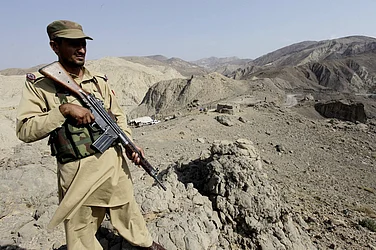At the Natipora government high school in Srinagar, Manzoor Ahmad Dar prefers to use English, Urdu and Kashmiri as the medium of instruction. He says at times one has to use the Kashmiri language even in an English class. Dar says there is a marked improvement in the performance of government schools over the past few years, as English is now understood by most students. Over the past two years, a number of students from private schools have enrolled in government schools due to the economic slowdown caused by Covid-19, and teachers like Dar see it as a blessing for government schools. He says since students of private schools are well-versed in English, it becomes easy for other students to pick up the language. Dar feels eventually, students would prefer English as a medium of instruction.
Dar’s optimism about the English language is bound to be deflated by the recently released National Education Policy (NEP), which states that preference will be given to mother tongues and regional languages as medium of instruction. While many states are deliberating whether to implement the NEP, Jammu and Kashmir under Governor’s rule is likely to do so.
ALSO READ: Let A Language Contend
According to the Union Territory’s director of academics, Dr Farooq Ahmad Peer, the government of J&K issued an order in 2002, making the English language a medium of instruction in schools. In 2017, the state government also ordered that regional languages such as Kashmiri, Dogri and Budhi be taught in areas where sizeable local populations speak them.
While Urdu continued as an official language of the state, English was the de facto official language. In 1889, Maharaja Pratap Singh, the third ruler of the Dogra dynasty, replaced Persian with Urdu as the court language. “The Maharaja understood the immense benefit of Urdu to his rule. From Jammu to Jhelum Valley district (now in Pakistan-administered Kashmir), Urdu was what bound people together. And it still does. It helped the Dogra rulers consolidate the vast and diverse region into one linguistic unit,” says Professor Shohab Inayat Malik, dean of the Faculty of Arts, University of Jammu.
After 1947, the Constituent Assembly of Jammu and Kashmir understood the importance of Urdu as the connecting language, and continued with it as an official language of J&K. In official communications, it was slowly replaced by English, after the government extended all Indian services to J&K in 1962. As non-local officers of the Indian Administrative and Police services started working in J&K, they began giving preference to English over Urdu.
The system worked well till September 2, 2020, when the Union Cabinet, headed by Prime Minister Narendra Modi, approved the Jammu and Kashmir Languages Bill, 2020, to declare five languages—Urdu, Hindi, Kashmiri, Dogri and English—as official languages of the region. Later on September 23, the J&K Official Languages Bill 2020 was passed by a voice vote in the Rajya Sabha. “The bill fulfils the decades-long wishes of the people of the region,” said the Union minister of state (MoS), home affairs, G. Kishan Reddy. To justify his claim during the debate on the bill, Reddy quoted the 2011 Census that showed the number of Urdu speakers in J&K to be a mere 19,956, i.e., 0.16 per cent of the population, compared to 66,80,837 of Kashmiri, 26,12,631 of Hindi, 25,96,767 of Dogri and 2,19,193 of Punjabi. This way, the BJP government ended the 131-year-old status of Urdu as the sole official language in J&K.
However, senior journalist Anuradha Bhasin says the Census also reveals higher usage of Urdu as a language of communication other than the mother tongue, i.e., second language, than Hindi and English. “The official claim of ‘20,000’ Urdu speakers is based on selective data from one chart pertaining to mother tongues [scheduled languages],” she says.
Unlike the Kashmir Valley, in Jammu, linguistic fault-lines are more visible, as a vast majority of people in the Pir Panjal region speak Gojri and Pahari, while in the Chenab Valley, people speak Urdu and Kashmiri, and refugees from West Pakistan speak Mirpuri. In three districts where the Dogra population is in a majority, Dogri is spoken along with Hindi.
Under the Sixth Schedule of the Constitution of the erstwhile state of J&K, Kashmiri, Dogri, Balti (Pali), Dardi, Punjabi, Pahari, Ladakhi and Gojri were considered regional languages of the state.
The 2020 government move triggered demands for the inclusion of more languages in the proposed legislation. Gujjars, Paharis and Sikhs, for example, have sought official language status for Gojri, Pahari and Punjabi. In 2020, the government sanctioned the establishment of an Official Languages Section in the General Administration department for translating important statutory orders, government orders and other important government documents. According to officials, while this section has already translated some important statutory orders, completing the translation of orders and statutes in all five languages will take time.

The government’s decision to clear the five-language status for J&K—in spite of the Jammu and Kashmir Re-Organisation Act 2019 that empowers the J&K assembly to decide which languages to adopt for official communication—indicates that the BJP government at the Centre has taken over powers of the J&K legislative assembly. Section 47 of the Act says, “The Legislative Assembly may by law adopt any one or more of the languages in use in the Union Territory of Jammu and Kashmir, or Hindi, as the official language or languages, to be used for all or any of the official purposes of the Union Territory of Jammu and Kashmir.”
By not leaving anything for the assembly to decide, and by coming up with its five-language formula, the Centre pre-empted decisions that any future J&K assemblies might want to take.
Professor Malik says there is no region in the country, barring J&K, where five official languages are in vogue. He says the BJP has certain ideological goals, one of which is to impose Hindi as the national language. “In line with its ideological views, the party has declared several languages as official in J&K. I see it as a clear move to have Hindi as the official language of J&K,” he says. He adds that in the long run, no one would use Kashmiri or Dogri in official communications, Urdu will be phased out, and Hindi will be normalised.
Days after the government implemented the five-language formula, former chief minister Mehbooba Mufti described the move as part of a pattern being followed since the abrogation of Article 370 on August 5, 2019. “Whether it is changing Urdu as an official language, or declaring new domicile laws, or removing Muslim officers from the civil secretariat, or giving rights on the state’s resources—including sand—to outsiders—they (New Delhi) don’t need the people of J&K. People of J&K are expendable. They only want our land,” says Mehbooba.
National Conference MP, Hasnain Masoodi, agrees with Professor Malik. He says the BJP should have waited for the legislative assembly to take a decision on it. “Since the abrogation of Article 370, the government is in hurry to implement its own agenda in J&K,” he adds, saying, “In the coming years, they will also start issuing orders in Hindi, while phasing out both English and Urdu.”
(This appeared in the print edition as "The Hinditva Mission")
ALSO READ
Naseer Ganai in Srinagar


























